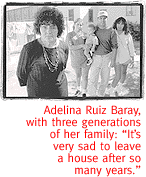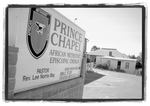
A Downtown African Methodist Episcopal Church Prepares To Evict Two Longtime Tenants And Demolish Their Homes.
By Margaret Regan
A LOT HAS happened in Adelina Ruiz Baray's house since
she first moved in with her husband, Miguel, in 1955.
The big three-bedroom Victorian, a Queen Anne Revival brick from
the turn of the century, nowadays is listed on the National Register
of Historic Places, rundown as it is. But its high status as a
Tucson architectural gem didn't mean as much to the young couple
as the fact that the place had plenty of space for kids. There
was a big yard, and the attached apartment was just right for
Adelina's mother. They moved in. Over the years, one by one, Mrs.
Baray brought home eight new babies to the house.
Age 70 now, Mrs. Baray ticks off the accomplishments of the seven
who grew up. Alex is a schoolteacher, Arthur works for the city,
Mary Alice works in a senior center, Lidia works at a hospital.
She's not finished raising children yet, though. The Barays have
cared for their 7-year-old great-granddaughter from the age of
two months, and later took in her little brother, who's now age
5.
 The house has sad memories too, as houses do. It was 32 years
ago, right outside that window--Mrs. Baray points--that her 14-month-old
baby Magdalena, in the care of another woman, was struck and killed
by a car. And it was in the adjoining apartment that Mrs. Baray
nursed her elderly mother, Mercedes Ruiz, until her final illness
seven years ago.
The house has sad memories too, as houses do. It was 32 years
ago, right outside that window--Mrs. Baray points--that her 14-month-old
baby Magdalena, in the care of another woman, was struck and killed
by a car. And it was in the adjoining apartment that Mrs. Baray
nursed her elderly mother, Mercedes Ruiz, until her final illness
seven years ago.
Today, the house, at 23 W. 17th St., is still the physical heart
of the extended Baray family. On Sunday afternoon, there are four
great-grandchildren underfoot, and a pair of grown granddaughters
dash in and out. Mrs. Baray's sister Lupe drops in, bringing along
a daughter-in-law. Mr. Baray comes in from an errand, and grown
son Eddie retreats to a bedroom for privacy.
This whole rich intermingled history of the Barays and the Queen
Anne will end abruptly in just nine days. The Barays have been
renters for 43 years--a nest egg Mrs. Baray was hoarding for a
house payment went to pay for the funeral of baby Magdalena years
ago. The real owner of the house is Prince Chapel, the African
Methodist Episcopal Church just a stone's throw to the east, at
the corner of 17th and Stone. The church also owns a duplicate
next door at number 25, where members of Maria Cantú's
family have lived for about 25 years. The church's minister, the
Rev. Lee Norris May, is evicting both families at the end of the
month.
"It's very sad to leave a house after so many years,"
Mrs. Baray says. "My mother lived here. I lived very happily
here, even being poor, I was happy here. Those other ministers
fixed up the place. I would like it if he would give me a little
more time. I cannot find a place. They charge too much."
The Barays and the two great-grandkids survive month to month
on Social Security and a small pension Mr. Baray collects from
his years in construction. It covers the $350 rent, car payments,
utilities and not much more. Mrs. Baray says it's going to be
next to impossible to put together the hundreds of dollars for
a deposit and first month's rent on a new place.
Next door, at number 25, it's much the same story. The Cantús
have three children. Maria Cantú says the Rev. May raised
the rent as soon as he replaced the old minister. He moved it
from $225 up to the $300, still below market, but the Cantús,
like the Barays, have mostly done all the upkeep on the old house.
 "Since May, he told us we have to move," Cantú
says. "It's hard to find a place. Apartments don't want kids
and we have three."
"Since May, he told us we have to move," Cantú
says. "It's hard to find a place. Apartments don't want kids
and we have three."
Contacted at the Prince Chapel, the minister, the Rev. May, declines
to say what the church plans to do with the empty properties.
Neighbors have heard rumors that the church wants to demolish
the houses to make way for a parking lot. Neighbor John Crow says
the minister told him the church is looking for larger quarters.
If the church leaves the neighborhood where it's been since 1904,
people worry that the whole church complex could give way to a
commercial development. So far, though, the city department of
development services has issued no permits for demolition.
Told that the families have yet to find new homes, Rev. May was
asked if the church could help them.
"We've done a lot to help them," Rev. May said by telephone.
"They hardly paid any rent for them (the houses). The houses
belong to the church and we need them at this point."
Local preservation experts say the houses' historic status doesn't
protect them from the wrecking ball. The National Register can
be invoked only if a demolition project is using federal money,
says Marty McCune, historic program administrator for the city.
The local historic district governing Barrio Historico has more
teeth--but its boundary begins just a few houses to the west at
Rubio Alley, bypassing the houses. Outside a historic district,
there's nothing the city can legally do to prevent the houses
from being leveled, McCune says.
Steven Paul, vice president of the Barrio Historico Neighborhood
Association, says the church's actions are all wrong for a couple
of reasons.
"They're displacing long-term residents and we need more
residential downtown, not less," he says. "If you want
to be a neighborhood you've got to have people there. The worst
case for this site would be a parking lot. The best case would
be for it to remain residential. A horrible case would be to replace
the house with some sort of commercial building."
Paul says the houses, as part of an intact turn-of-the century
block, add up to more than the sum of their parts. The church's
two Queen Annes adjoin a third that's in private hands.
"The fact that those three contiguous houses are on the
West side of Stone, they're a bridge between the older Sonoran
style flush-front adobe neighborhood of Barrio Historico and the
post-railroad Victorian neighborhood of Armory Park."
A longtime neighbor on 17th Street is worried about more empty
space in a barrio already pockmarked by weedy lots that once held
historic houses.
"We're trying to keep the neighborhood nice and family oriented,"
says Guadalupe Montaño. Residents have been making headway
in clearing out gangs, drug dealers and groups of men who drink
in the alleys, Montaño says, and "this is opening
up the door to an empty lot. Houses give a better feeling to a
neighborhood."
Just north of Prince Chapel sits the Stone Avenue Temple, the
city's first Jewish house of worship. For the last four years,
the Stone Avenue Temple Project has been working energetically
to raise the money to restore it, says president Toby Sydney.
They had a congenial relationship with Rev. May's two predecessors
at Prince Chapel, collaborating on events and considering future
historical projects together. All that changed with the arrival
of Rev. May, Sydney says.
 "He has not been willing to reach out," she says. "We're
saddened that people who have been longtime residents of the neighborhood
will lose their homes. We don't see why that's necessary. We're
a historic preservation project (at the Temple). We're dismayed
that two more buildings are coming down and we're worried about
how that affects the integrity of the neighborhood--there is so
little left in Tucson."
"He has not been willing to reach out," she says. "We're
saddened that people who have been longtime residents of the neighborhood
will lose their homes. We don't see why that's necessary. We're
a historic preservation project (at the Temple). We're dismayed
that two more buildings are coming down and we're worried about
how that affects the integrity of the neighborhood--there is so
little left in Tucson."
McCune, the city staffer, says she's willing to meet with the
Rev. May to see if the city can help.
"Let's see if we can avoid demolition. Is there a way for
us to help you accomplish what you're trying to accomplish?"
Mrs. Baray hopes so. Her high blood pressure's been acting up
since she got the bad news, and she's been feeling depressed.
Her husband's praying for a solution. Up on the kitchen wall,
above the oilcloth-covered table where so many family meals have
taken place, is a shrine. A print of "The Last Supper"
echoes the table below, and an array of saint's candles are positioned
on a shelf.
On Sunday, the flames are flickering behind the painted Sacred
Heart of Jesus.
"My husband is very religious," says Mrs. Baray. "He
lights the candles every day. He was thinking God will help us
and we won't have to move. But I stopped believing when he told
us we have to get out."

|





